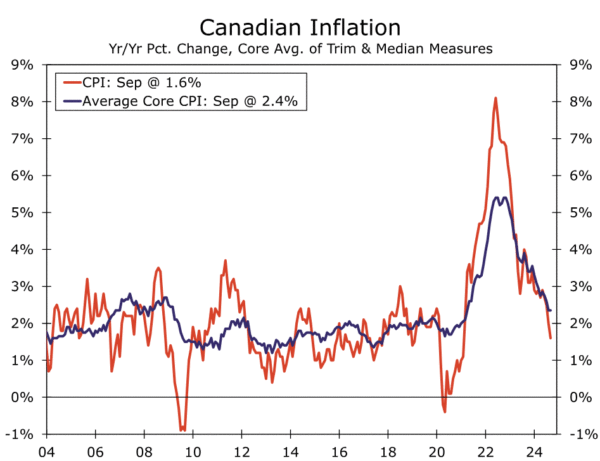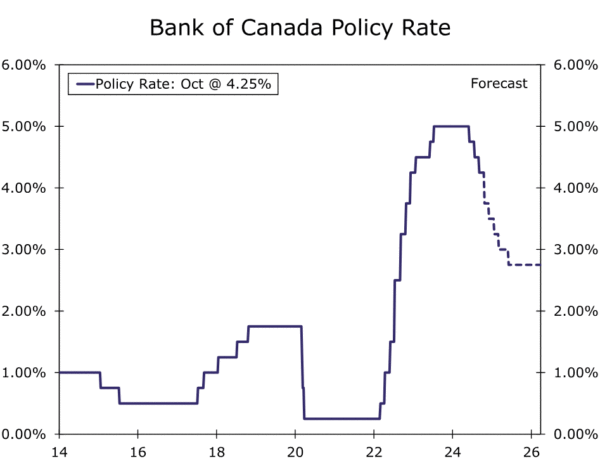Summary
- Today’s release of Canada’s September CPI offers a decisive data point, in our view, that should see the Bank of Canada (BoC) step up the pace of monetary easing next week.
- In addition to headline inflation surprising to the downside, broader underlying inflation pressures also remained contained. With activity data subdued overall, and with policy interest rates still some way above neutral and next week’s announcement accompanied by fully updated economic projections, we now forecast the BoC to cut its policy rate by 50 bps to 3.75% at its October 23 meeting.
- We expect the BoC to revert to 25 bps rate cuts at its December, January, March and June meetings, for a terminal policy rate of 2.75% by the middle of next year. Relative to our prior forecast, we see the central bank lowering interest rates more quickly and, moreover, view the risks as tilted to even faster monetary easing if growth in economic activity disappoints.
Ongoing Disinflation Points to Faster Bank of Canada Rate Cuts
Today’s release of Canada’s September CPI offers a decisive data point, in our view, that should see the Bank of Canada (BoC) step up the pace of easing, and lower its policy interest rate by 50 bps at next week’s monetary policy announcement. September headline inflation slowed more than consensus economists expected to 1.6% year-over-year, and while that deceleration was driven by an 8.3% decline in energy prices, there were also indications that underlying price pressures are contained. Services inflation slowed to 4.0%, the smallest increase in services prices since September of last year. Meanwhile, the average core CPI remains close to the central bank’s 2% inflation target, rising 2.4% over the past 12 months, by a 2.4% annualized pace over the past six months, and by 2.1% annualized over the past three months.
Meanwhile, while Canadian activity data is a bit more mixed, we also believe it is consistent with a 50 bps rate cut next week. July GDP rose 0.2% month-over-month, although the advance estimate is for a flat outcome in August, which, if realized, would leave the level of July-August GDP just 0.25% above its April-June average—tracking well below the Bank of Canada’s Q3 growth forecast of around a 0.7% quarter-over-quarter (not annualized) gain. More recent activity and survey data are not quite as soft. September employment rose by 46,700, driven by full-time jobs, and the unemployment rate fell to 6.5%. Offsetting that strength to some extent, the labor report also showed that wage growth eased by more than expected, to 4.5% year-over-year. Finally, the BoC’s Q3 business outlook survey showed a modest improvement in expectations for future sales, and the headline business outlook indicator improved to -2.3, although that reading for the business outlook indicator is still reflective of overall net pessimism rather than net optimism.
A couple of other factors are also supportive of a larger rate cut at next week’s announcement. First, the policy interest rate remains some way above neutral, which the BoC estimates to be in a range of 2.25% to 3.25%. In addition, next week’s announcement will also be accompanied by fully updated economic projections. Both of these factors argue for a larger rate cut, considering the subdued economic backdrop. Accordingly, we now forecast the BoC will lower its policy rate by 50 bps to 3.75% at its October 23 announcement, and by a further 25 bps to 3.50% in December. In 2025, we expect 25 bps rate cuts in January, March and June, which would bring the policy rate to 2.75% by middle of next year. Among the factors we think will see the Bank of Canada revert back to smaller 25 bps increments following the October move are policy interest rates that are moving somewhat closer to neutral, hints of improvement in some of the more recent activity data, and the potential for (and desire to avoid) excessive Canadian currency weakness. That said, relative to our prior forecast we see the Bank of Canada lowering interest rates more quickly to the same 2.75% terminal rate we had previously anticipated. Moreover, we view the risks as still tilted toward even faster monetary easing should inflation remain contained, and if growth in economic activity disappoints.
















